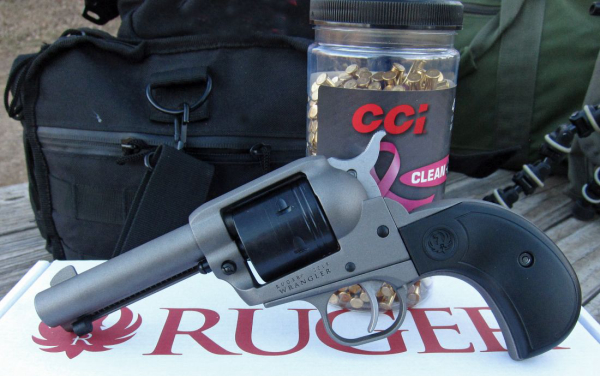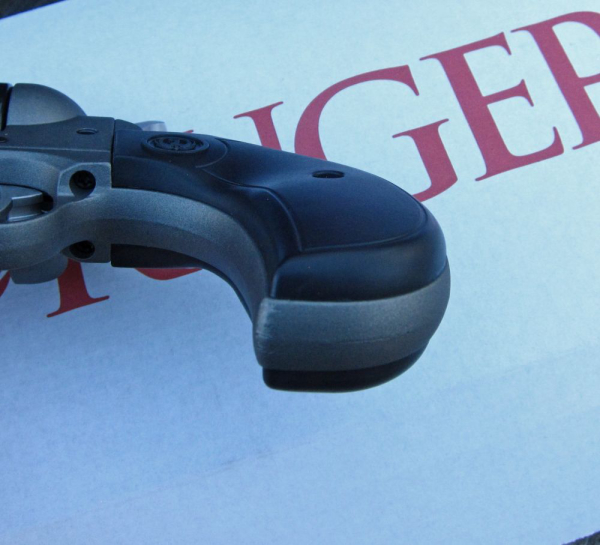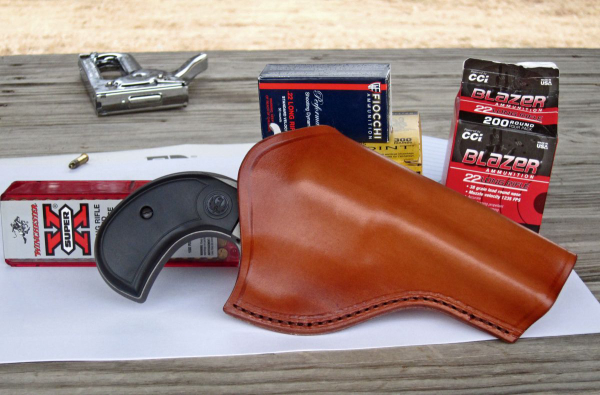Editor’s Note: Today’s feature first appeared in our companion service, The Shooting Wire.

My first real handgun shooting experience – involving bricks of 22LR ammo – were with a borrowed Colt Single Action Frontier Scout 22 LR. As I recall the gun was brightly nickeled, 4 5/8” barrel (or so), and it had wood stocks – walnut, I believe. The owner had it in a “TV western” drop loop holster on a cartridge belt.
This was in the late 1960’s. He had allowed me to take it on several trips to the local strip mine “dumps” to engage targets of opportunity. It seems a lot of people thought to discard items in such locations, making them an environment rich in targets, with plenty of tall dumps from the strip mining operations for backstops.
As I recently discovered via internet search engines, the series of guns I most likely used was called the “K” series of Frontier Scouts. Introduced in 1960, at least some of these featured bright nickel- plated finishes. An early use of zinc in domestic gun production, Zamak alloy was used to make receivers, grip frames and loading gates. Heavier than the previously used aluminum 22 revolver lines, the K-revolvers had stocks of plain walnut. (This information was from the Colt Forum, written by one Bruce Buckner. – Many thanks!)
At first, I was unimpressed with my lack of success; the brightly polished and plated top strap and sights prevented a sharp sight picture. The sight radius was short. While Dad’s Springfield 47A had a long sight radius, the rear sight was on the barrel and more precision could have theoretically been had with a receiver sight. But the Colt was very unforgiving compared to the rifle.
I persevered. It took a little time and some effort, but I got to where I could shoot that little gun quite well.

A few weeks ago, a gun reminiscent of that first ‘using’ handgun appeared at the local gun shop. It was the Ruger Wrangler .22 LR Revolver “With Bird's Head Grip.” The invoice showed it had the model number 2016, a gun with a “Birdshead” grip frame and synthetic stocks. They weren’t simply flat panels, nor rounded exactly; but contoured. It was a remarkable fit to my hand.

A six-shot 22 revolver, the barrel measures in at 3 ¾” – taking the base pin out to remove the cylinder is not fun. As the front end of the base pin is truncated, rounded and grooved for grip, it’s not hard to get started out of the frame. It’s getting it out far enough to remove it from the frame without running into the contact end of the extractor rod.
It’s beefy and doesn’t feel lightly constructed – though it’s no behemoth. It weighs in at around 28 ounces. The cylinder frame, made of aluminum alloy, is finished in silver Cerakote. The sights are old frontier style with a rounded front blade and a sighting trough along the top of the cylinder frame.
Retailing for less than $280, it won’t break the bank. The Ruger Wrangler has the standard Ruger “New Model” (a bit of a misnomer this far along) safety design. The gun has a transfer bar (not a hammer block). One has to press the trigger to bring the transfer bar up in line with the frame-mounted firing pin. The hammer is cut such that it can’t reach the firing pin; it strikes the transfer bar and that allows ignition.
For that reason, there is no half-cock notch in the hammer and no “four-clicks” heard when the hammer is cocked. My eldest offspring finds the lack of the clicks disconcerting and has been the only complaint I’ve heard from him regarding his Wrangler.
The transfer bar/loading gate interlock feature allows loading the cylinder up; no need to load ‘five beans in the wheel.’ Slip another biscuit in the oven, it’s drop-safe.
But don’t drop it. Just trust the technology.
On my first range trip, I shot from fifteen yards shooting two-hand unsupported, for “accuracy” and to determine zero. I found that Fiocchi 22FLRN 40 gr. LRN put six hits into 3 1/3” (the load shot two inches high). The best three of the six went into 2”. CCI Stinger 32 grain HP shot 1 ¾” high and five of six into 2 ¾” (without my called flier). The best three hits went into 1 ¾”.
I shot CCI Blazer for "just plain fun" shooting. I found that I started along unsure and not well practiced in shooting such a gun. It seemed to come back quickly.
The Wrangler came around the same way as my long-lost experience with the Colt Frontier Scout – with fewer rounds expended this time. I’d already made this trip over fifty years ago. It was just a matter of catching up.
I wish I’d had this gun sooner. I wish I’d owned something like this when I was a kid … and when I had kids.
But it’s here now. And it’s slow to shoot – but it can be a great educational tool as well as good fun around the camp.
In spite of wintery weather, I resolved to get the Wrangler Birds Head back out to the range. Finally, the ugly weather broke and the trip was made. Cloudy and only 46°F, it was still a little cool but it was nice enough to give the 22 a fighting chance. Using the club’s Rimfire Range and moving the shooting table back to give a legit 20 yard distance to the closest target board/backstop, I selected five loads for an accuracy test.
I found that CCI Clean-22 40gr. was the closest to point of aim at that distance, though I was still using a 6 o’clock hold as the gun shoots high – and it tends right with all ammo. I figure that the rightward shift is due to my grip and trigger contact.
It put five rounds into 2 ¼”, with three of those crowding into 7/8”. Blazer 38gr. lead roundnose put five hits into 2 3/8” with the best three clustering into 1 ¼”. Fiocchi 40 LRN had a similar group at 2 ½” and Winchester SuperX 40 grain HV and SuperX PowerPoint hit into 3 ½” and 3”, respectively.
I decided to try a different gun with a couple of the loads – different action, sights and trigger but similarly not known as a match gun, the GLOCK 44. With it, the Winchester SuperX 40gr. HV load gave a 3 ¾” group (part of that was me, as the best three went into 1 ¼”, close to the performance in the Ruger Wrangler.)

The CCI Clean-22 put five hits into 2 7/8” with three hits clustering into 7/8” – just like the Wrangler.
This gives me a pretty good baseline to predict that the Wrangler Birds Head will tend to be a 2-3” grouping gun at 25 yards, depending on the handler, environmental conditions and the ammo.
As he knew this gun was coming, Rob Leahy, holster impresario, fixed up one of his Eldorado holsters. He says it’s a simple open mouth Western style holster for revolvers, good for range and field use. It can be used, with the “Conventional Adapter,” on his “Chesty Puller” harness to make the Eldorado a chest holster, handy for use in the fishing streams or on the ATV or tractor on the property.
The Wrangler fits deeply in the holster, covering the trigger guard – and most of the gun – an asset for a field rig. It’s a great example of the leather-maker’s art.
And the Wrangler is a great choice for those outdoors chores too … as long as you’re not expecting bears.
It’s a great gun for fun -- and fun is what got a good many of us into the shooting sports.
-- Rich Grassi